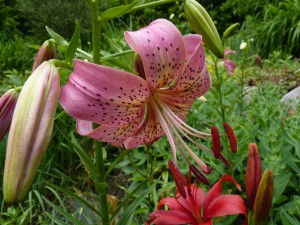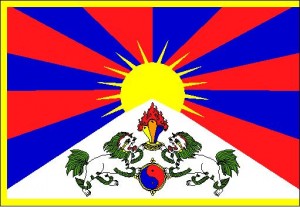by Rebecca Novick
When the young Gyatsho Tshering approached the Tibetan government with the idea to build a library he was told that he was crazy. “They said, ‘This is impossible. You’re just dreaming.’” Tshering could see their point. “But I am a dreamer. I just go on trying and trying.”

Gyatsho Tshering (1936 – 25th June 2009)
It was 1967, during the early and challenging days of exile. The re-established Tibetan government, overwhelmed and under-funded, was struggling to provide for 100,000 traumatized and penniless refugees, flooding over the Himalayas fleeing the Chinese occupation. But Tshering had his sights set further than the immediate needs of food and shelter.
Tibetan Buddhist texts had been arriving in the sub-continent across Tibet’s borders since 1959—carried on the backs of these same refugees. Tshering was profoundly impressed by how many people, only able to bring with them what they could carry from their homes, chose to rescue dharma objects from their altars; pechas (Buddhist texts) statues and thangkas (sacred scroll paintings) rather than items of monetary value.
Tshering was deeply concerned that the millennium-old heritage of Tibetan wisdom was being destroyed by Communist forces in Tibet. Inspired by the stories of the great library of Alexandria in ancient Egypt built to house the knowledge of the world, he wanted to create a safe repository to preserve “the skill of the Tibetan mind.” He finally took his “impossible” dream to His Holiness the Dalai Lama who gave the project his blessing. “He was very pleased,” Tshering recalls. “He said, ‘Why not? Go ahead.’”
But there were a few considerations. Firstly, there was no money. “We didn’t have any funds,” said Tshering. “Not one cent. Not one penny.” During visits to the West, he would always try to bring up his vision with potential supporters. He was repeatedly, if politely, turned down, with the explanation that the library would be a religious rather than educational establishment. But Tshering refused to become disheartened and he eventually found an ally in the Catholic Church that understood the importance of religious archives. “They were very generous,” he said. After this, other funders gradually began to come on board.
The texts that managed to survive the punishing conditions of high altitude passes and a rugged month-long trek in the packs of Tibetans dodging Chinese bullets, formed the library’s very first collections which can still be seen today. Manuscripts were landing on Tshering’s desk battered and torn, with missing pages and passages smudged beyond recognition from snow and rain. It was clear that the challenges went far beyond those of cataloguing and archiving. This was first and foremost a restoration project.
A team of the most learned Tibetan scholars was assembled—monks who had spent decades studying in the great monastic institutions of Tibet. “It had been part of their study to commit many of the texts to memory,” said Tshering. They worked from dawn often into the late hours of the night, filling in the missing parts of the texts by hand with nothing but their own memory as a reference.
Gyatsho Tshering expressed his regret that with the computer-age Tibetan calligraphy is fast becoming a lost art. “Tibetan calligraphy has power. It has energy. That is something that I miss. But what can we do? The times have changed.”
The manuscript restoration team lived without electricity in shacks that before them had housed cows. “We were living hand to mouth, but we didn’t care. We spent whatever we had that day even though we didn’t know what we would eat tomorrow.” Lamp oil was considered more precious than food. “Every day was a day of excitement for us because every day we discovered a new and rare manuscript.”
Gyatsho Tshering’s most vivid memory of that time was the support that he and his team received from His Holiness the Dalai Lama. “He would personally take the time to come down and encourage each one of us.”
The construction of the library building began in 1969 and took four years to complete and became known as the Library of Tibetan Works and Archives. But just as it was mostly the contributions of ordinary Tibetans who filled its shelves, it was the contribution of the poorest and most disenfranchised Tibetans that stood out in its construction.
In those days, many Tibetans were literally carving out a living on road crews in the harsh North Indian mountain states, sleeping and eating in dust-filled tents, and earning a meager 3 rupees a day. Many of these workers put aside one rupee and donated it to the construction of the library. Others even took unpaid leave to come to Dharamsala to volunteer as laborers on the building project. Said Tshering “They built it as if it was for themselves. That was very moving.”
As the Library of Tibetan Works and Archives began to gain international recognition acquisitions started to arrive not just from Tibet but also from Mongolia, Germany, and America. Private individuals began donating their personal collections, including a number of gifts that had been given to them or their family members by the Thirteenth Dalai Lama. Tibetan scholars and academics from around the world began making regular visits to Dharamsala to the library that was becoming renowned for its rich and comprehensive collection of authentic Tibetan texts. Tshering recalled people like Jeffrey Hopkins, Robert Thurman, Stephen Batchelor, Alan Wallace and Alexander Berzin who went on to become seminal figures in the Tibetan Buddhist movement in the West. “I remember every one of them,” he said fondly.
Today, the Tibetan Library houses the entire collections of Tengyur and Kangyur —the complete Indian commentaries on the Buddha’s sutras and the Tibetan Buddhist canon respectively. Every evening you can find Tibetans, generally the older ones, ambling clockwise around the building, rolling prayer beads through their fingers. “Wherever you find the collection of Tengyur and Kangyur, you will find people doing circumambulation around them,” noted Tshering. “Whenever they feel sad, whenever there is someone sick in their home, or when they want to find consolation, they go to the library and pray.”
“The library was a pioneering institution in many ways. We started a thangka painting school, a woodcarving school, a philosophy school. We had the cream of the scholars. Each one of them was a specialist in some field of Tibetan learning.” The original idea was for the library to house only written works, but Tibetans were arriving with so many statues, and other religious artifacts that Tshering saw the need to also incorporate a museum. “To outsiders it’s a museum, but to Tibetans it’s something living.”
Tibetans going back and forth from Tibet in the 60s and 70s were often requested to look out for missing parts of key manuscripts that made up the monastic curriculum, and without which monks could not complete their studies. Although they risked arrest and imprisonment for bringing such items out of Tibet, to Tshering’s knowledge no one ever got caught. He believed that there are still many important texts and documents languishing in drawers and file cabinets in Tibet, some that could prove politically “sensitive” for the Chinese authorities who have no interest in seeing them made public.
Born in 1936 in Gangtok, Sikkim, a country where Tibetan Buddhism dominates, Gyatsho Tshering grew up with a love of Tibetan culture, particularly its literature. “The attitude of the Tibetan people towards Buddhist philosophy was very different to now,” he observed. The generation of which he was a part, was in his view motivated by a purity of purpose and a sense of altruism that’s becoming harder to find in the Tibetan community. “Nobody thought to extend their hand to outside help,” he said. “We all thought, if we don’t do it, who will do it for us?”
Tshering served as the director of the Tibetan Library from up until 1998, after which he moved to the United States because he said, “I needed some rest”. He also wanted to have more time for his personal spiritual practice—an ironic reversal of the West-East trail that has led legions of Westerners to seek spiritual opportunities in Asia.
“I feel very satisfied that I was able to do something that was very much of benefit not only to Tibetans but also to people around the world. I’m a very lucky person in that I led a useful life. I have no regrets. When I die, I will die in peace.”
Gyatsho Tshering passed away at the age of 73 on 25th June 2009.
—–
This article is based on an interview with Gyatsho Tshering that took place in the summer of 2007 in Dharamsala. Rebecca Novick is a regular contributor to The Huffington Post and the founding producer of The Tibet Connection radio program online at thetibetconnection.org
 weeks ahead, at least that stuff that I got in the ground at temperature, but not date, appropriate times. I know, this is weather and that’s climate, still, one measure of the advance of global warming is earlier springs, which bring earlier plant blooming cycles. Of course, one year is not a trend.
weeks ahead, at least that stuff that I got in the ground at temperature, but not date, appropriate times. I know, this is weather and that’s climate, still, one measure of the advance of global warming is earlier springs, which bring earlier plant blooming cycles. Of course, one year is not a trend.
 believe, leaves yearnings for past deeds, past achievements and lost loves behind us, where, I believe, they belong.
believe, leaves yearnings for past deeds, past achievements and lost loves behind us, where, I believe, they belong.

 When they die, a unique aspect of our life here comes to a finish. It is the unique and the special traits or memories we recall when we speak of them in later years. Celt’s stepping on my snow shoes, barking at the flapping black plastic bag, receiving attention at the St. Kate’s Art Fair as if it were his due. Buck’s careful positioning of the pillows and blankets so he could lie down on the perfect spot. Iris retrieving and shredding tissues. Emma standing on the tree.
When they die, a unique aspect of our life here comes to a finish. It is the unique and the special traits or memories we recall when we speak of them in later years. Celt’s stepping on my snow shoes, barking at the flapping black plastic bag, receiving attention at the St. Kate’s Art Fair as if it were his due. Buck’s careful positioning of the pillows and blankets so he could lie down on the perfect spot. Iris retrieving and shredding tissues. Emma standing on the tree.